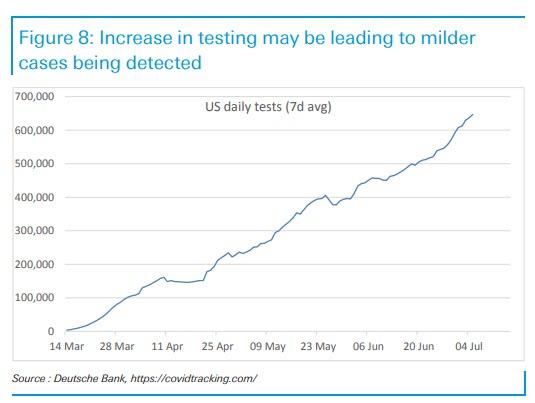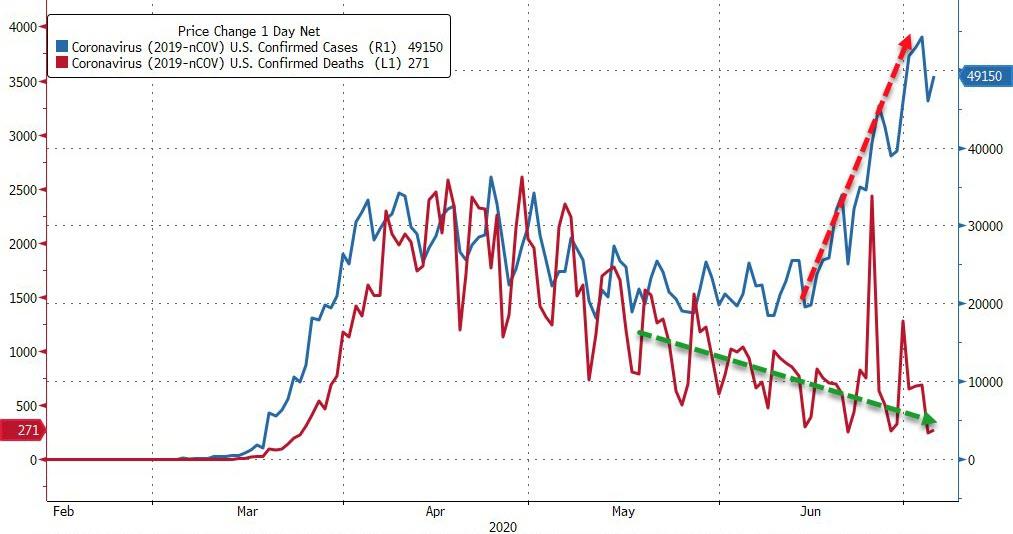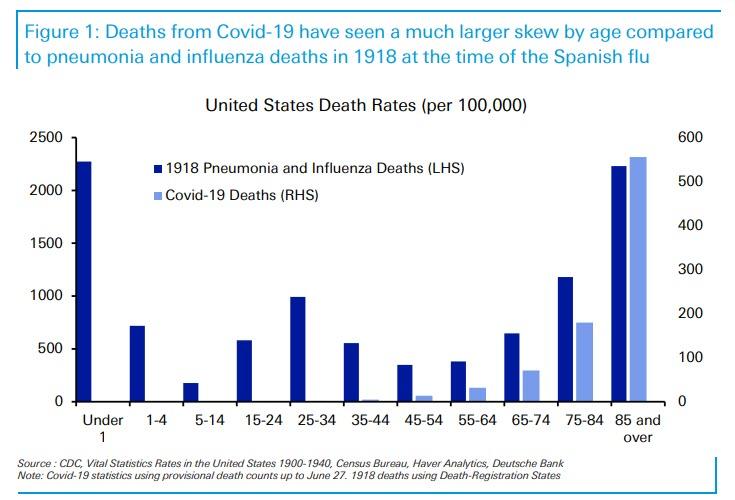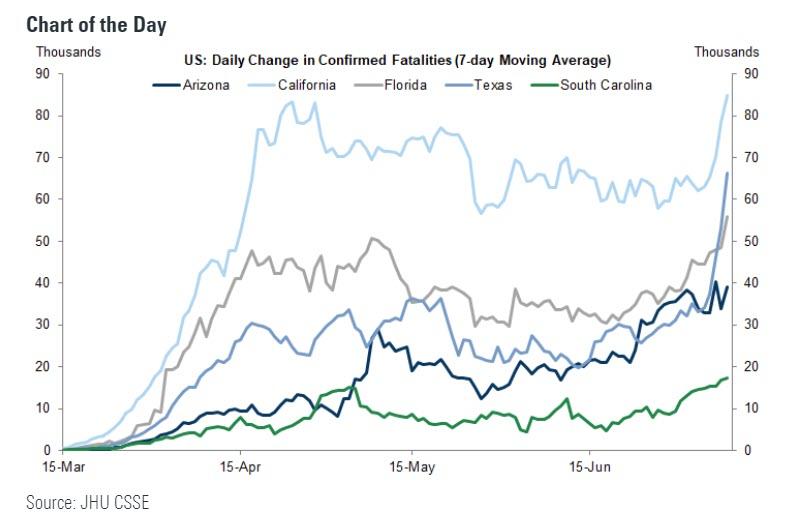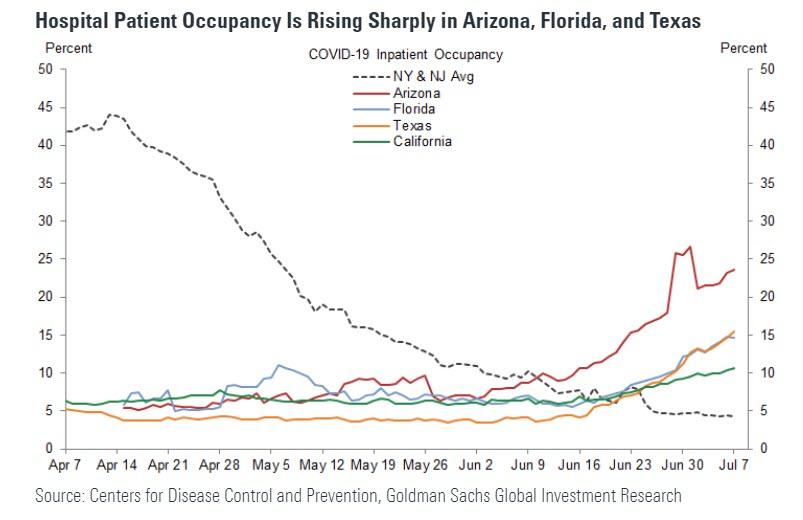Goldman Spots An Ominous Turning Point In The US Coronavirus Pandemic
Tyler Durden
Fri, 07/10/2020 – 11:25
Earlier this week we asked if “everyone was wrong” about the ongoing impact of the coronavirus pandemic, when we pointed out that despite the surge in new covid-19 cases, which according to Bank of America was largely a function of far more widespread testing, deaths were declining.
Specifically, we referred to a recent note by Nordea’s strategist Andreas Steno Larsen, who was looking at the growing divergence between the number of new covid cases in the US and shrinking number of fatalities, and observed that “we are entering “crunch time” on fatalities since they should start to rise in early July given the lead/lag structure versus new cases.“
As Larsen further predicted, “if fatalities don’t spike early in July, then people will conclude that it’s probably spreading amongst a part of the population that is not as sensitive, or that it is a resulted of increased testing or that the virus has become less deadly as we move into the summer months. Governors in Texas, California and Florida seem to have concluded that the below correlation holds, but the jury is still out.”
His conclusion was that “the next 6-10 days will be crucial.”
With that in mind, we followed up on Larsen’s prediction one week later, and we found that there still no spike in fatalities at either the federal level or state level.
Which prompted us to ask whether “most experts were wrong that the surge in cases would also lead to a spike in deaths?” We also showed recent data compiled by Deutsche Bank, which could explain the lack of a rise in the mortality rate. As DB’s Jim Reid showed, unlike the 1918 Spanish Flu pandemic, there has been a major difference with the current covid crisis, namely in the age distribution of fatalities:
As DB further pointed out, for Covid-19, the elderly have been overwhelmingly the worst hit. For the Spanish flu of 1918, the young working-age population were severely affected too. In fact, the death rate from pneumonia and influenza that year among 25-34 year olds in the United States was more than 50% higher than that for 65-74 year olds, “a remarkable difference to Covid-19.”
So was it the case that the latest wave of covid was simply far less dangerous than the Spanish Flu, or were we merely counting the chickens early? After all, as Larsen said 10 days ago, the crunch time could take as much as 10 days to emerge.
Fast forwarding to today, in a troubling observation that suggests we may have indeed been premature with our optimistic assessment, Goldman’s writes that on Thursday confirmed cases in the US increased by 63K, the largest daily increase observed in the country so far. More concerning, however, is that while new fatalities have not begun to climb substantially at the country-level, some states with high rates of case growth have started to see an acceleration in deaths, which as shown below, is Goldman’s Chart of the Day.
Still, as even Goldman concedes, the increase in new fatalities has not been as rapid as that of new cases, and just like BofA, Goldman adds that “This likely reflects, at least partially, greater testing, which has captured more low-risk cases and, perhaps, more high-risk cases at earlier stages of infection, resulting in a longer lag between confirmed cases and deaths.”
In a separate ominous observation, Goldman also notes that hospitalizations are rising nationally as well, and COVID-19 patients now occupy 7.4% of hospital beds nationwide, up 2% compared to two weeks ago. As the bank further details, “patients receiving treatment for COVID-19 in Arizona hospitals now occupy nearly a quarter of total capacity. In Texas, and Florida, COVID-19 patient occupancy is still doubling about every two weeks. In each of these three states new case growth is still high and accelerating. In Georgia, Maryland, Nevada, South Carolina, and Alabama, COVID-19 patients occupy at least 10% of total hospital capacity while available capacity is already quite low. Prevalence of symptoms and cases are still increasing in each of these states.”
Still, putting the rise in hospitalizations in context, even Arizona – the most severely impacted state – still has another 20% to go before it catches up to where NY and NJ were at their peak.
Bottom line: it is still too early to rule out that the ongoing increase in cases across the US won’t necessarily translate into higher deaths.
via ZeroHedge News https://ift.tt/2DuTpet Tyler Durden
